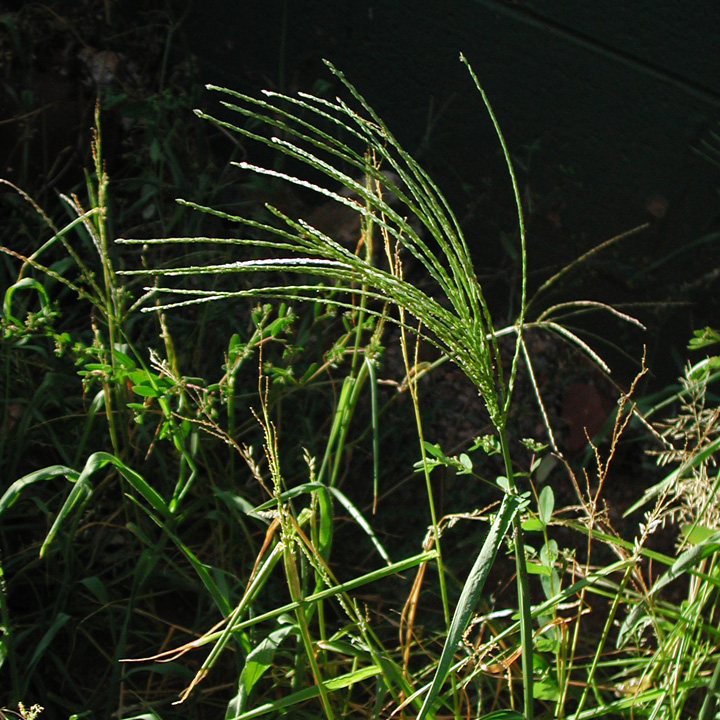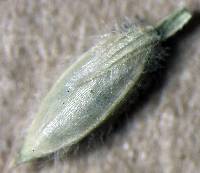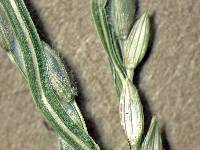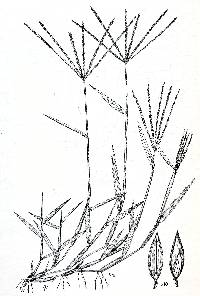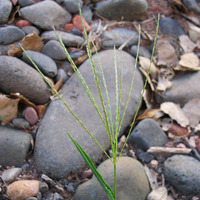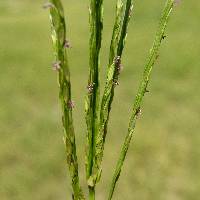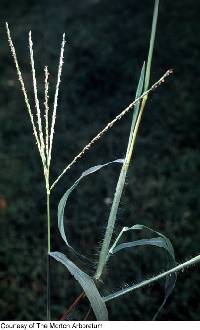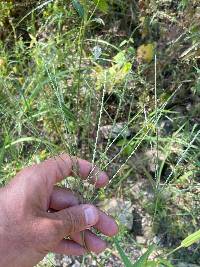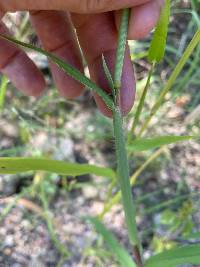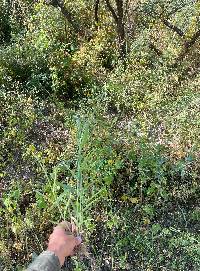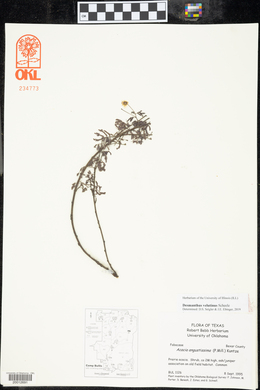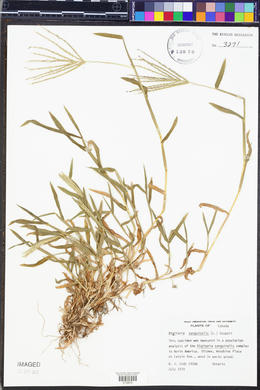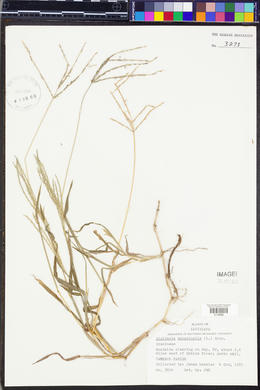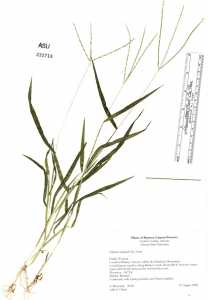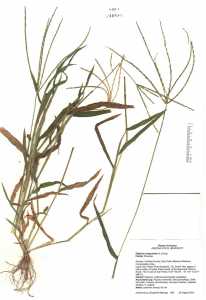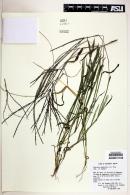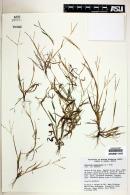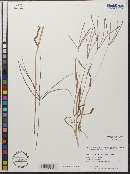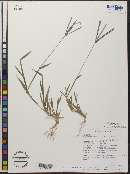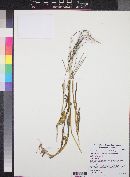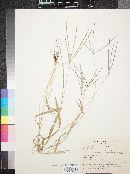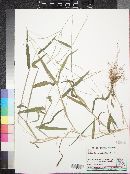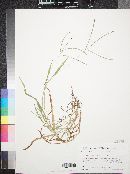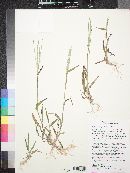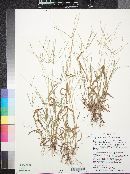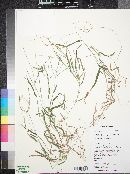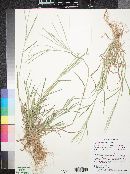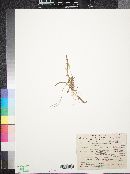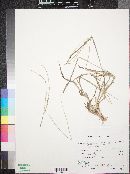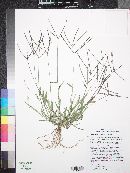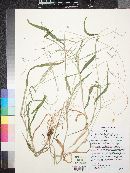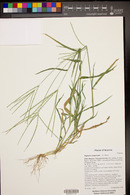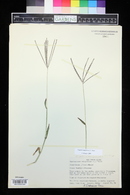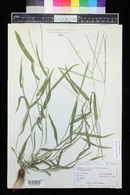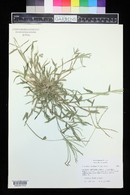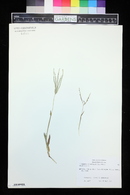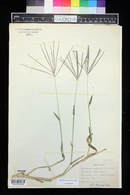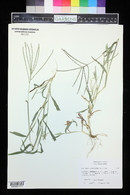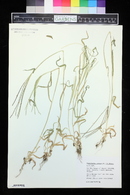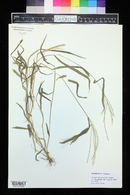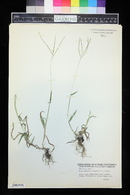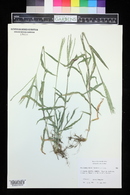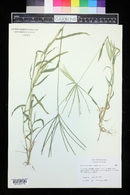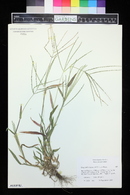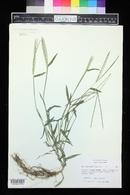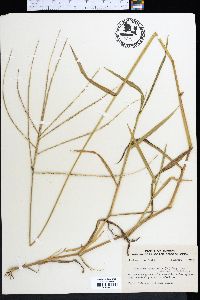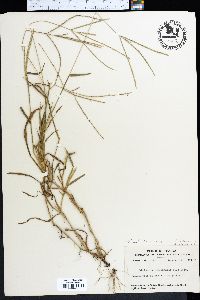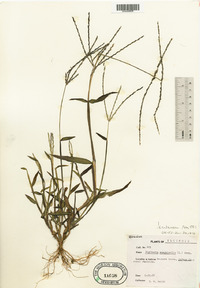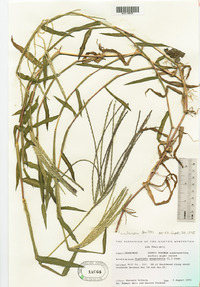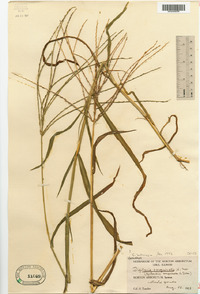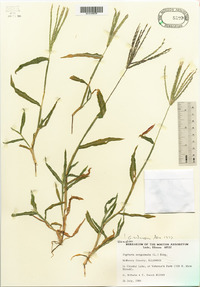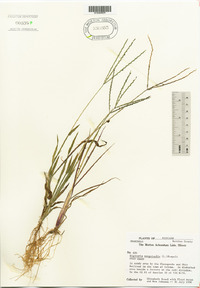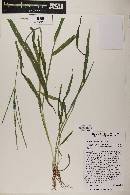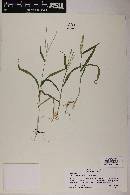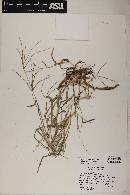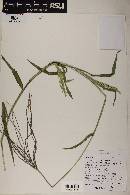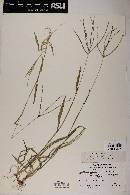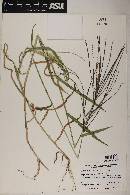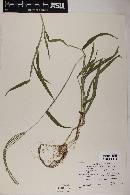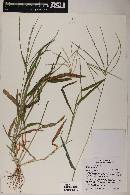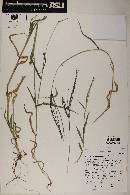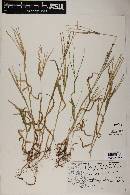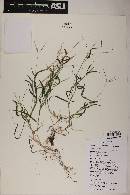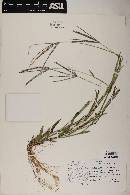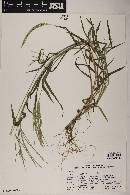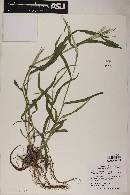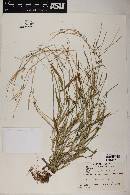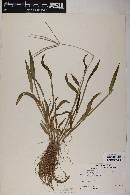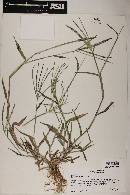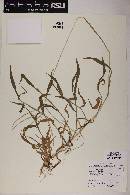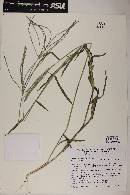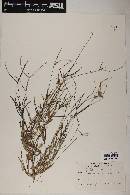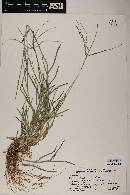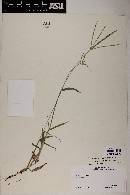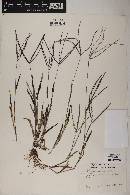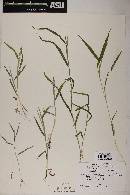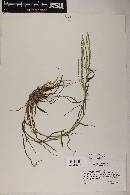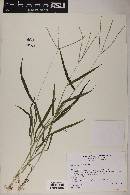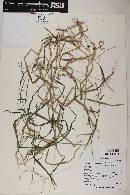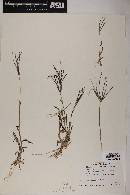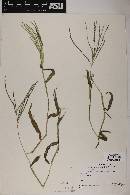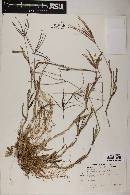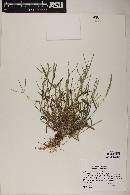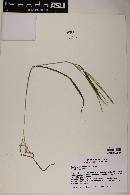Digitaria sanguinalis
|
|
|
|
Family: Poaceae
Hairy Crab Grass, more...hairy crabgrass, Crabgrass, large crabgrass, purple crabgrass, redhair crabgrass, Digitaire Sanguine (es: zacate cangrejo, zacate cangrejo velludo)
[Asperella digitaria Lam., moreCynodon praecox (Walter) Roem. & Schult., Digitaria ciliaris f. intercedens Beck, Digitaria plebeia Phil., Digitaria praecox (Walter) Willd., Digitaria sanguinalis subsp. vulgaris (Schrad.) Henrard, Digitaria sanguinaria Steud., pro syn., Digitaria vulgaris (Schrad.) Besser, Milium sanguinale (L.) Roxb., Panicum sanguinale L., Panicum sanguinale var. vulgare (Schrad.) Döll, Panicum sanguinalis L., Paspalum sanguinale (L.) Lam., Syntherisma praecox Walter, Syntherisma sanguinalis (L.) Dulac, Syntherisma vulgare Schrad., Syntherisma vulgaris Schrad.] |
Plants annual. Culms 20-70(112), often decumbent and rooting at the lower nodes. Sheaths keeled, usually sparsely pubescent with papillose-based hairs; ligules 0.5-2.6 mm; blades 2-11(14) cm long, 3-8(12) mm wide, usually with papillose-based hairs on both surfaces, sometimes glabrous. Panicles with 4-13 spikelike primary branches, these subdigitate or on rachises to 6 cm; primary branches 3-30 cm long, 0.7-1.5 mmwide, flattened and winged, wings more than 1/2 as wide as the midribs, lower and middle portion of the branches with spikelets in unequally pedicellate pairs, pedicels not adnate to the branches; secondary branches rarely present. Spikelets homomorphic, 1.7-3.4 mm long, 0.7-1.1 mm wide. Lower glumes 0.2-0.4 mm long, veinless; upper glumes 0.9-2 mm, 1/3-1/2 as long as the spikelets, 3-veined, pubescent on the margins; lower lemmas usually exceeded or equaled by the upper florets, sometimes exceeding them but by no more than 0.2 mm, glabrous, 7-veined, lateral (or all) veins scabrous throughout or smooth on the lower 1/3(1/2) and scabrous distally, 3 middle veins usually widely spaced, remaining veins on each side close together and near the margins; upper lemmas 1.7-3 mm, yellow or gray, frequently purple-tinged when immature, often becoming brown at maturity; anthers 0.5-0.9 mm. 2n = 36, 28, 34, 54. Digitaria sanguinalis is a weedy Eurasian species that is now found in waste ground of fields, gardens, and lawns throughout much of the world, including the Flora region. Annual herb 20 cm - 1 m tall Leaves: alternate, two-ranked. Sheaths open, keeled, sparsely hairy with bumpy-based hairs. Ligules 0.5 - 2.5 mm long, membranous. Blades 2 - 12 cm long, 3 - 8 mm wide, flat, parallel-veined, sometimes with bumpy-based hairs. Inflorescence: a terminal arrangement of spikelet-bearing branches (panicle). Primary branches four to thirteen, nearly palmate (or on axes to 6 cm), 3 - 30 cm long, 0.5 - 1.5 mm wide, spike-like, compressed and winged. Rarely having secondary branches. Fruit: a caryopsis, indehiscent, enclosed within the persistent lemma and palea, flat on one side and convex on the other (plano-convex). Culm: often decumbent, 20 cm - 1 m long, round in cross-section, rooting at the lower nodes. Spikelets: 1.5 - 3.5 mm long, 0.5 - 1 mm wide. Florets: two per spikelet. Lower florets sterile. Upper florets bisexual. Anthers three, 0.5 - 1 mm long. Stigmas red. Glumes: Lower glumes to 0.4 mm long, lacking veins. Upper glumes 1 - 2 mm long, one-third to one-half as long as spikelet, three-veined, hairy along the margins. Lemmas: Lower lemmas equal to upper lemmas, more or less equal to upper florets, seven-veined (unequally spaced), membranous. Upper lemmas grayish or yellow, often tinged purple when young, becoming brown at maturity, 1.5 - 3 mm long, obscurely veined, with margins that embrace the upper paleas. Paleas: Lower paleas absent. Upper paleas similar in size and texture to upper lemmas. Similar species: No information at this time. Flowering: late June to mid-October Habitat and ecology: Introduced from Europe. Common in a variety of habitats, including lawns and waste ground. It is also found in railroad ballast and cultivated fields. Occurence in the Chicago region: non-native Etymology: Digitaria comes from the Latin word digitus, meaning finger, referring to the digitate inflorescence of some species. Sanguinalis means "stanching blood," referring to the plant's supposed ability to stop bleeding. Author: The Morton Arboretum FNA 2003, Gould 1980, Heil et al 2013 Common Name: hairy crabgrass Duration: Annual Nativity: Non-Native Lifeform: Graminoid General: Annual grass with spreading-decumbent stems, often rooting at lower nodes, 10-130 cm. Vegetative: Sheaths and blades pilose to thinly pubescent; blades broad, flat, 4-10 mm wide, 5-10 cm long; ligule membranous, truncate, erose, 0.5-1.5 mm long; collar divided, somewhat pilose. Inflorescence: Branches long and thin, 3-30 cm long, usually digitate or clustered at stem apex but occasionally scattered along the stem; small spikelets in pairs, the 2 spikelets in each pair identical except one is sessile and the other on a pedicel about 1/2 the length of the spikelet; spikelets 3 mm long, with 2 florets, the first floret sterile and the second floret fertile; first glume a minute scale, second glume pubescent, mostly one-half or less as long as spikelet, leaving the back of fertile lemma exposed; fertile lemmas 2-3 mm, yellow or gray, frequently purple-tinged when immature, often becoming brown at maturity. Ecology: Common weed of lawns, open waste ground, and cultivated areas from 2,500-6,000 ft (762-1829 m); flowers June-October. Distribution: Native to central Asia and the Mediterranean; naturalized throughout the world; in North America from the southern Canadian provinces through the lower 48 US states and into Mexico. Notes: Quite different from its regionally abundant native congener D. californica. D. sanguinalis is an annual grass, geniculate and rooting at lower nodes, with thin, delicate branches in its inflorescence, in contrast to D. californica which is an upright perennial bunchgrass with a distinctively silvery-white hairy inflorescence. More likely to be confused with bermuda grass Cynodon dactylon, which also has geniculate lower stems rooting at the nodes and digitate inflorescences, but is perennial and strongly stoloniferous, forming extensive mats, and usually has much shorter inflorescence branches, less than 6 cm long, compared to D. sanguinalis which has inflorescence branches up to 30 cm long. Also similar to Chloris virgata, another annual grass with digitate inflorescences, but C. virgata-s spikelets have delicate hairlike awns 5-10 mm long. Ethnobotany: Historically cultivated as grain for human consumption in Poland and Germany; also grown as fodder for livestock. Etymology: Digitaria is from Latin digitus, finger, referring to the digitate inflorescences; sanguinalis pertains to blood, alluding to the sometimes reddish foliage. Synonyms: Panicum sanguinale, Syntherisma sanguinalis Editor: SBuckley 2010, AHazelton 2015 Decumbent or prostrate, much branched, rooting at the nodes, usually 3-6 dm; sheaths and blades papillose-pilose, the blades 4-10 cm × 5-10 mm; racemes 3-6 in each of 1-3 whorls, 5-15 cm; rachis 1 mm wide, broadly winged, scabrous on the margins; pedicels triquetrous, scabrous; spikelets 2.4-3.2 mm; first glume minute, often deciduous, the second 0.8-1.8 mm, a third to three-fifths the length of the spikelet; sterile lemma usually scabrous on the 5 strong veins; fertile lemma grayish-brown; 2n=18-76, mostly 36. Native of Europe, now cosmop. and established as a weed of lawns, fields, gardens, and waste places throughout our range and w. to the Pacific, giving way southward to no. 5 [Digitaria ciliaris (Retz.) Koeler].
From Flora of Indiana (1940) by Charles C. Deam This species is a common weed throughout the state, especially in truck gardens, lawns, gardens, and cultivated grounds of all kinds. ...... Indiana Coefficient of Conservatism: C = null, non-native Wetland Indicator Status: FACU Deam (1929): In pastures and in cultivated fields that can be pastured in summer and fall it is a valuable forage plant. |
|
|
|

